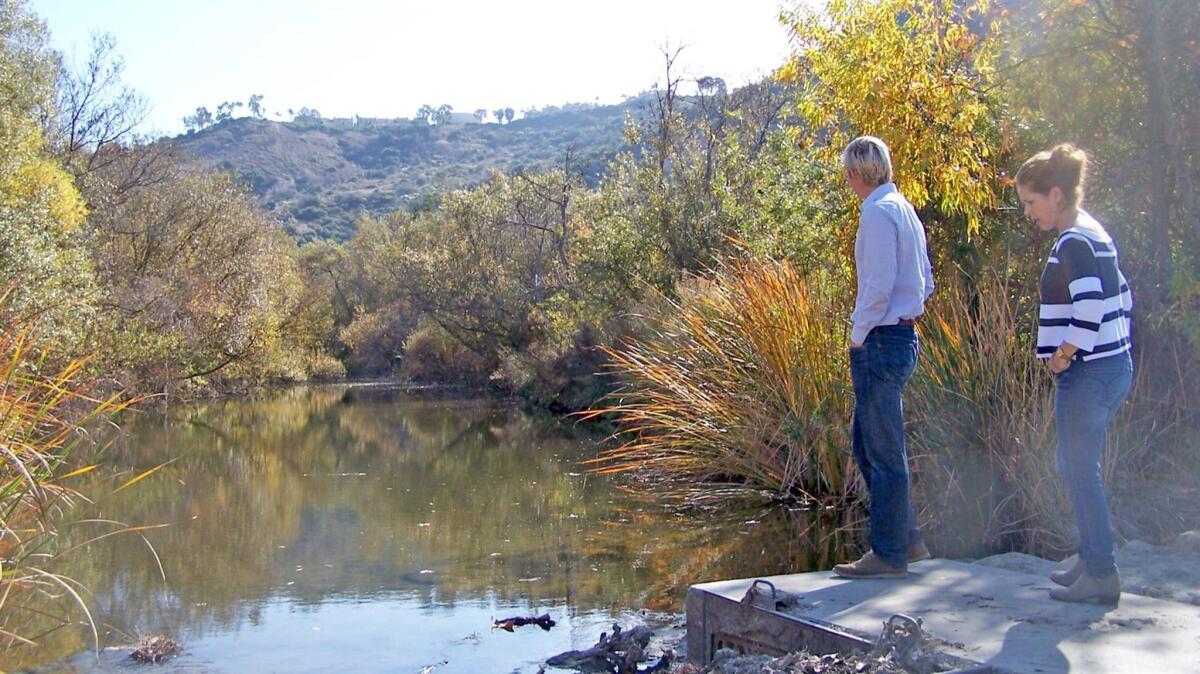How to restore Aliso Creek’s watershed? Agencies’ plans differ

Most agree that a 5-mile section of the 35-square-mile Aliso Creek watershed, which stretches from the Cleveland National Forest to Aliso Beach Park in Laguna Beach, would benefit from restored habitat and improved water quality. The question is how.
The U.S. Army Corps of Engineers gave its answer to that question in a plan released in September.
The city of Laguna Beach and multiple organizations, including the Laguna Canyon Foundation, have their own ideas and are working on an alternative plan to restore the 191 acres of habitat.
The land in question sits along a stretch of Aliso Creek from Pacific Park Drive in Aliso Viejo to the South Orange County Wastewater Authority’s coastal treatment plant, which sits 1.2 miles upstream of Aliso Creek’s ocean outfall.
A majority of the project area lies within Aliso & Wood Canyons Wilderness Park, which is owned, operated and managed by the county.
Corps’ engineers, whose plan included draft feasibility and environmental impact reports, want to raise the stream bed and widen the creek channel to create a larger floodplain. They propose adding rock riffles — shallow land forms — in scattered locations to stabilize the creek bed.
Increasing the floodplain improves wildlife habitat, Dena O’Dell, deputy public affairs chief of the Corps’ Los Angeles district, wrote in an email.
Floodplains provide spawning grounds for fish, along with shelter and foraging space for birds, she added.
Amphibians, such as salamanders and the Southwestern pond turtle, would benefit from more moist soil, the Corps’ report said. The pond turtle, a California Species of Special Concern, lives in few locations of Orange County.
The creek has and continues to face pressure from decades of development. Dirtied water from upstream cities funnels into Aliso Creek and eventually the Pacific Ocean at Aliso Beach Park.
Larger volumes of water, traveling at higher speeds, caused the creek to cut deeper into the earth — incisions in some locations reach 25 feet or more — while destroying wetlands that were once a hallmark of the area.
As the creek eroded, stream banks steepened, limiting growing surfaces for vegetation.
“It needs a gentle slope for good, lush vegetation,” said Jonathan Vivanti, water resources chief of the Corps’ planning division.
Steeper banks can speed the loss of soil, which in turn could harm nearby sewer pipes, the report states.
To help prevent such damage, Laguna Bluebelt Coalition officials have suggested using this project as a time to re-route the sewer lines farther from the creek, according to a letter the organization sent to the Corps.
Crews would use bulldozers to excavate and move thousands of pounds of dirt. The Corps will not haul dirt off-site, Vivanti said, and some 300,000 cubic yards in excess would be scattered within the park.
The 5-mile stretch of the Aliso Creek watershed has been on the county and Corp’s radar for 20 years.
Laguna Beach officials said while nothing is being done the area is being further degraded.
“Until the creek reaches equilibrium, it will be difficult to maintain vegetation and adjacent infrastructure, such as utilities, pipelines and roads,” according to a Nov. 28 letter from the city.
In its letter, the city said the Corps’ report is lacking important details. The city said there is no mention of the number of truck trips required to move dirt during excavation, nor does the report address potential impacts to air quality, traffic and noise.
Laguna claims the Corps’ strategies would require “significant destruction” of habitat and creek function.
Vivanti said the long-term goal of re-establishing a connection between riparian habitats within the watershed requires heavy equipment, but that it’s a temporary impact.
“Yes, we are moving a lot of native vegetation there,” Vivanti said. “We can re-create, build the floodplain.”
The project would progress in phases, and crews could start planting trees after the first phase, he added.
The estimated project cost, including design and construction, is $96.8 million and would take four years. The Corps would cover 65% while the county, the lead agency on the project, would contribute the remaining 35%.
The county’s share would include cash, work-in-kind and land, Marilyn Thoms, the county’s watershed manager, said.
Why has the project taken this long to get to this stage?
“We had the recession [2008] in the middle of this,” Thoms said. “The projects that were getting built were focused on human life.”
As examples, Thoms mentioned levees and other flood-control projects.
“A lot of [federal] funding was directed toward the Santa Ana River project,” Thoms said. “If that was not in place, hundreds of thousands of people would be affected if there was flooding.”
The proposed project is separate from a plan to restore the Aliso Creek estuary, farther downstream at the creek’s mouth.
The Laguna Ocean Foundation is hoping to work with the California Coastal Conservancy to enhance water quality and restore an 11-acre area for plants and animals, including the tidewater goby fish and Western pond turtle.
Proliferation of non-native plants has hindered biological diversity, according to the Corps’ study.
Arundo donax is the main culprit, according to restoration ecologist and Laguna Canyon Foundation board member Derek Ostensen. The foundation focuses on protection and preservation of Laguna Coast and Aliso & Wood Canyons wilderness parks.
Arundo, a reed species, grows in clusters about 6 inches apart. Ostensen and a crew of volunteers and county workers spent the last six years removing millions of pounds of arundo from the watershed.
“Invasive plants create dams that prevent water from flowing naturally through the flood plain,” Ostensen said, adding that this process confines water to a channel and exacerbates erosion. “It steals water and grows 25 feet tall.”
Once crews removed the arundo, the creek started flowing naturally, spreading sand along the floodplain, Ostensen said as he knelt down and scooped a palm full of white-colored sand.
The city said recent arundo removals have helped the creek retain sediment and gravel.
Ostensen and Hallie Jones, the foundation’s executive director, said creek health is improving and recommend restoration that limits habitat and wildlife destruction and reduces the amount of grading and excavation.
“Our plan will protect critical infrastructure, safeguard sensitive environmental and public resources, and improve habitat and water quality in Aliso Creek — all at a dramatically lower cost, which can be funded with outside grants, mitigation and other sources,” Ostensen said in a follow-up email.
The foundation has worked on habitat restoration in the Aliso Creek watershed since 2010.
Crews planted native trees and shrubs and pulled out invasive species such as arundo.
“Aliso Creek is an incredible resource for Laguna Beach and surrounding communities,” Jones said. “It’s important we all work together to restore it in the most environmentally — and fiscally responsible — way.”
The Corps will evaluate comments from the public and Orange County supervisors will eventually vote on a project to support, O’Dell said.
Twitter: @AldertonBryce
More to Read
Sign up for Essential California
The most important California stories and recommendations in your inbox every morning.
You may occasionally receive promotional content from the Los Angeles Times.











